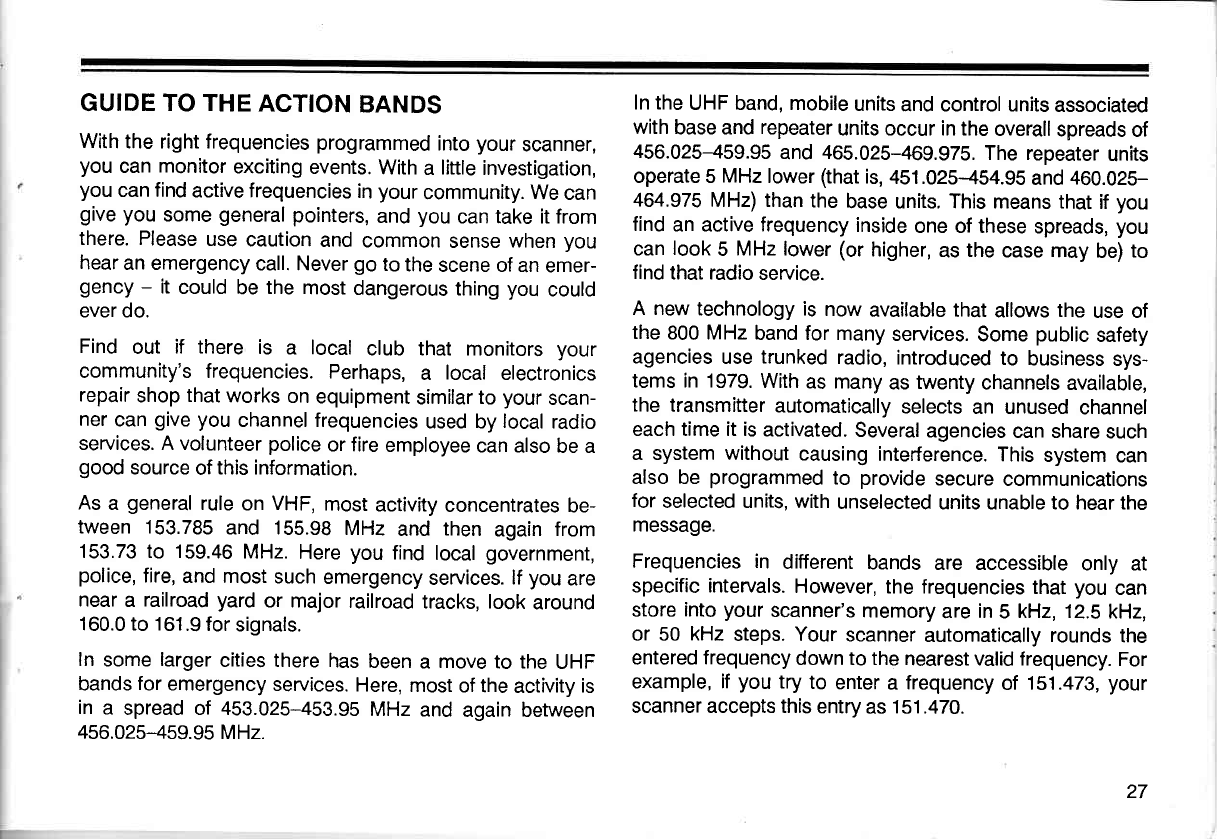
GUIDE
TO THE
ACTION
BANDS
With
the right frequencies programmed
into
your
scanner,
you
can
monitor
exciting
events.
With
a
little
investigation,
you
can find
active frequencies
in
your
community. We
can
give you
some
general
pointers,
and
you
can take it from
there. Please
use
caution
and
common
sense
when
you
hear
an emergency
call. Never
go
to
the
scene of
an emer-
gency
-
it
could
be
the
most
dangerous
thing
you
could
ever do.
Find
out
if there
is
a local
club that monitors
your
community's frequencies.
Perhaps,
a
local
electronics
repair
shop
that
works
on
equipment
similar
to
your
scan-
ner
can
give
you
channel frequencies
used by
local
radio
services. A volunteer
police
or fire
employee
can
also be a
good
source
of
this information.
As
a
general
rule
on
VHF,
most
activity
concentrates
be-
tween 153.785
and 155.98
MHz
and
then
again
from
153.73 to 159.46
MHz.
Here
you
find
local
government,
police,
fire,
and most
such
emergency
seruices.
lf
you
are
near
a
railroad
yard
or major
railroad
tracks, look
around
160.0 to 161.9
for
signals.
In
some
larger
cities there
has
been
a
move
to the
UHF
bands
for
emergency
services.
Here,
most
of the
activity
is
in
a
spread of 453.025-453.95
MHz
and
again between
456.025-459.95
MHz.
In the
UHF band, mobile
units
and control units
associated
with
base and
repeater
units occur in the
overall
spreads
of
456.025-459.95
and
465.025-469.975.
The repeater
units
operate 5
MHz
lower
(that
is,
451.025-454.95
and
460.025-
464.975
MHz) than
the
base units. This means that
if
you
find
an active frequency
inside
one of these
spreads,
you
can
look
5
MHz lower
(or
higher,
as
the
case may
be)
to
find
that radio
seruice.
A new
technology is
now
available that
allows
the
use of
the
800 MHz
band for
many
services.
Some
public
safety
agencies
use
trunked
radio,
introduced
to
business
sys-
tems in 1979.
With
as many
as
twenty
channels available,
the
transmitter
automatically
selects
an unused
channel
each time it is
activated.
Several
agencies
can share
such
a system without
causing
interference.
This
system
can
also be
programmed
to
provide
secure
communications
for
selected units, with
unselected
units unable to hear the
message.
Frequencies
in
different
bands
are accessible
only at
specific intervals.
However,
the frequencies
that
you
can
store
into
your
scanner's
memory
are
in
5
kHz, 12.5
kHz,
or 50 kHz
steps. Your
scanner
automatically rounds
the
entered
frequency
down to the
nearest valid frequency.
For
example, if
you
try
to
enter
a
frequency
of
151.473,
your
scanner accepts this
entry
as
151.470.
27


















